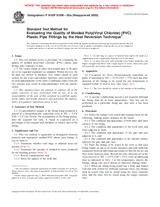Wir benötigen Ihre Einwilligung zur Verwendung der einzelnen Daten, damit Sie unter anderem Informationen zu Ihren Interessen einsehen können. Klicken Sie auf "OK", um Ihre Zustimmung zu erteilen.
ASTM F610/F610M-00a(2005)
Standard Test Method for Evaluating the Quality of Molded Poly(Vinyl Chloride) (PVC) Plastic Pipe Fittings by the Heat Reversion Technique (Includes all amendments And changes 12/31/2010).
Automatische name übersetzung:
Standard Test Method zur Bewertung der Qualität von Form Poly (vinylchlorid ) (PVC) Kunststoff-Rohrverbindungen durch die Hitze Reversion -Technik
NORM herausgegeben am 1.8.2005
Informationen über die Norm:
Bezeichnung normen: ASTM F610/F610M-00a(2005)
Anmerkung: UNGÜLTIG
Ausgabedatum normen: 1.8.2005
SKU: NS-55899
Zahl der Seiten: 4
Gewicht ca.: 12 g (0.03 Pfund)
Land: Amerikanische technische Norm
Kategorie: Technische Normen ASTM
Die Annotation des Normtextes ASTM F610/F610M-00a(2005) :
Keywords:
evaluating, fittings, plastic, PVC, quality, ICS Number Code 23.040.20 (Plastic pipes), 23.040.45 (Plastic fittings)
Ergänzende Informationen
| Significance and Use |
|
This test method is applicable to distinguish between properly and improperly molded PVC plastic pipe fittings. It can be used to: 3.1.1 Determine whether cold slugs or unfused areas are present (Note 1), 3.1.2 Determine the amount of molded-in stress produced by the molding process (Note 2), 3.1.3 Reveal contamination, and 3.1.4 Show the quality of the weld line. Note 1—A cold slug is a piece of material that enters the mold at a significantly lower temperature than the rest of the mass. Note 2—A stress-free part will generally have better properties and higher strength than those with a high degree of stress. Stress-free parts will generally react better when exposed to chemicals. |
| 1. Scope |
|
1.1 This test method covers a procedure for evaluating the quality of molded poly(vinyl chloride) (PVC) plastic pipe fittings after exposure to heat. 1.2 The values stated in either inch-pound units or SI units are to be regarded separately as standard. Within the text, the SI units are shown in brackets. The values stated in each system are not exact equivalents; therefore, each system must be used independently of the other. Combining values from the two systems may result in nonconformance with the specification. 1.3 This standard does not purport to address all of the safety problems, if any, associated with its use. It is the responsibility of the user of this standard to establish appropriate safety and health practices and determine the applicability of regulatory limitations prior to use. |
Empfehlungen:
Aktualisierung der technischen Normen
Wollen Sie sich sicher sein, dass Sie nur die gültigen technischen Normen verwenden?
Wir bieten Ihnen eine Lösung, die Ihnen eine Monatsübersicht über die Aktualität der von Ihnen angewandten Normen sicher stellt.
Brauchen Sie mehr Informationen? Sehen Sie sich diese Seite an.




 Cookies
Cookies
